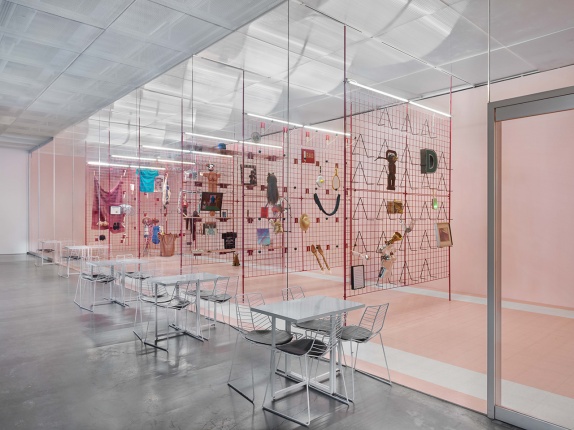
In her paintings, sculptures, performances, and installations, Pia Camil draws inspiration from the urban landscape of her native Mexico City and engages with the history of modernism. Her projects transform the remnants of dysfunctional commercial culture, revealing the inherent problems as well as the latent aesthetic potential within inner-city ruin. Often using laborious fabrication processes in collaboration with local artisans, Camil deaccelerates the frenetic pace of mass commodification through the handcrafted production and intimate quality of her works. In recent projects, she has expanded the scope of her practice to create theatrical environments that invite the viewer to navigate the exhibition space and experience shifting viewpoints and juxtapositions.
For “A Pot for a Latch,” Camil presents a participatory sculptural installation produced specifically for the Lobby Gallery. Inspired by the modular display systems typically used by vendors, Camil has constructed a succession of gridwall panels of her own design, complete with built-in hooks, shelves, and other fixtures for displaying items. Composed of grids, lines, and geometric shapes, the structures form a volumetric drawing within the space of the gallery, referencing cheap commercial constructions as well as the serial patterning of paintings and sculptures made by Minimalist artists such as Sol LeWitt and Agnes Martin.
The title of the exhibition refers to the potlatch, a ceremonial gift-giving festival practiced by the Native-American peoples of the Pacific Northwest coast, for whom it continues to be a system of wealth redistribution. Camil invites the public to participate in the ongoing creation of her piece on designated days, during which visitors are encouraged to exchange their own unique items for others in the installation. The composition on the gridwall panels is thereby in flux and is repeatedly altered throughout the course of the exhibition. With “A Pot for a Latch,” Camil transforms the Lobby Gallery into a shop of sorts, in which the monetary value of an object is supplanted by its personal history and significance.
New Museum visitors are invited to exchange items for those in the installation during a series of six public events.